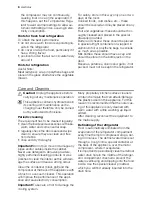
• Do not remove nor touch items from the
freezer compartment if your hands are
damp/wet, as this could cause skin abra-
sions or frost/freezer burns.
• Avoid prolonged exposure of the appli-
ance to direct sunlight.
Daily use
• Do not put hot pot on the plastic parts in
the appliance.
• Do not store flammable gas and liquid in
the appliance, because they may explode.
• Appliance's manufacturers storage rec-
ommendations should be strictly adhered
to. Refer to relevant instructions.
Storage of food in refrigerators and
rules of hygiene
The increasing consumption of prepared
meals and other delicate foods that are sen-
sitive to non-observation of the cold-chain
principle
2)
makes it necessary to have better
control of the temperatures at which these
products are transported and stored.
In the home, the correct use of the refrigera-
tor and strict observance of the rules of hy-
giene make a significant and effective contri-
bution to improving the preservation of food-
stuffs.
Storage of food / control of tempera-
tures
Store the foods in the appropriate area de-
pending on their type:
•
Moderate zone:
Drinks, eggs, butter,
commercial and home-made sauces, hard
cheeses, fruit and fresh vegetables.
•
Fresh zone:
Dairy products, desserts with
dairy content, fats, soft cheeses.
•
The coldest zone:
Meat, poultry, fish,
cold meats, prepared dishes, mixed sal-
ads, foods based on eggs or cream, fresh
dough, cake dough, pizza and quiches,
fresh foods and cheeses with raw milk,
ready-to-eat vegetables sold in plastic
bags and more generally any fresh product
with a “best-before” date related to a stor-
age temperature of +4°C or lower.
Observing the following advice will help to
avoid cross-contamination and to prevent in-
correct storage of the foods:
• Always wrap the foods to prevent them
from contaminating each other.
• Wash your hands before handling food
and several times while preparing a meal if
this requires successively handling differ-
ent products and, of course, afterwards
when going to the table to eat, as required
by the rules of hygiene.
• Do not re-use utensils that have already
been used (wooden spoons, chopping
boards) without first washing them well.
• Wait for prepared food to cool down fully
before storing it (example: soup).
• Limit the number of times the door is
opened and in any case do not leave it
open for too long, to avoid a rise in tem-
perature inside the refrigerator.
• Arrange the food in such a way that the air
can circulate freely round it.
There should be regular checks for correct
temperature, particularly in the coldest area
and, if necessary the temperature control
should be adjusted as described (see the
page on Usage).
Measurement of the temperature
in an
area (such as on a shelf) can be done by us-
ing a thermometer placed, from the start, in
a water -filled container (glass). To obtain a
good representation of the true value, read
the temperature without adjusting the con-
trols or opening the door.
Respect for the rules of hygiene
• Clean the refrigerator interior frequently,
using a mild product without an oxydizing
effect on the metal parts, then rinse with
water containing lemon juice, white vine-
gar or any disinfectant suitable for refriger-
ators.
• Remove the extra packaging from food
items before placing them in the refrigera-
tor (for example the outer packaging of
packs of yogurt).
• Cover the foods.
• Always read the instructions for use of the
appliance and in particular the mainte-
nance instructions.
Care and cleaning
• Before maintenance, switch off the appli-
ance and disconnect the mains plug from
the mains socket. If you cannot come to
the mains socket, interrupt the power sup-
ply.
2) Cold-chain: process used to maintain optimal conditions of food, starting at the manufacturer and
ending with the usage of the food by the consumer.
4
electrolux
Содержание ARA34280W
Страница 1: ...user manual Refrigerator ARA34280W ...
Страница 15: ...electrolux 15 ...
Страница 16: ...212700331 00 03042009 www electrolux com ...


































